How to Build PropTech Solutions for Real Estate Success in 2025
- December 16
- 30 min

Definition: Retail and Commercial Space Management refers to the comprehensive oversight and optimization of physical commercial properties, including shopping centers, malls, office buildings, and mixed-use developments. This discipline encompasses tenant relations, lease administration, facility maintenance, financial management, operational efficiency, and strategic space planning to maximize property value, tenant satisfaction, and overall profitability while ensuring regulatory compliance and sustainable operations.
Retail PropTech solutions are revolutionizing the way property managers manage commercial spaces in today’s competitive market. As consumer behaviors shift toward omnichannel experiences and operational costs continue rising, traditional property management methods fall short of meeting modern demands. These innovative technology platforms provide comprehensive solutions for tenant management, financial transparency, and operational efficiency.
From automated invoicing systems to smart building technologies, retail PropTech solutions enable property managers to create vibrant, profitable spaces that serve both tenants and customers effectively. This comprehensive guide explores practical implementation strategies, real-world benefits, and measurable outcomes for shopping malls, food courts, and retail outlets.
The commercial real estate landscape has undergone a fundamental transformation over the past decade. Property managers now navigate challenges ranging from e-commerce competition to sustainability requirements and evolving consumer expectations. Traditional management approaches, relying heavily on manual processes and reactive maintenance, struggle to keep pace with these demands.
Modern retail PropTech solutions address these challenges through automation, real-time insights, and strategic decision-making capabilities. These platforms integrate multiple property management functions into unified systems, providing comprehensive oversight and control.
E-commerce sales in the United States reached $870 billion in 2022, prompting physical retail spaces to justify their existence through unique value propositions (U.S. Census Bureau, 2023). Commercial buildings typically spend $2.14 per square foot annually on electricity, creating pressure to optimize energy consumption (Energy Information Administration, 2023). Smart building technologies can reduce these expenses by 20-30% through the use of automated systems and real-time monitoring (McKinsey & Company, 2022).
Key challenges faced by property managers include:
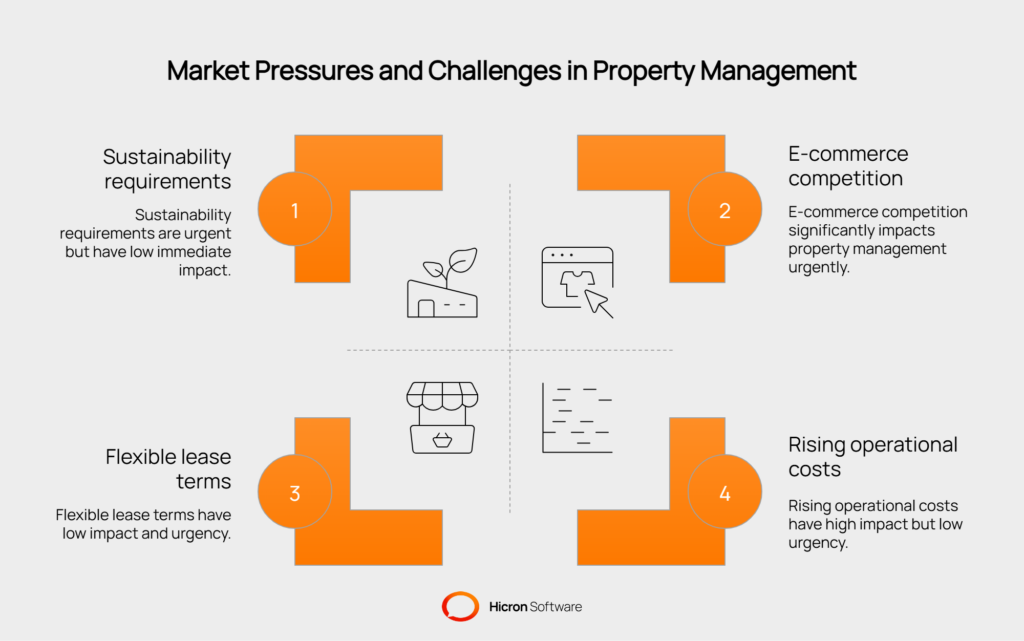
Tenant expectations have evolved dramatically. Modern retailers demand flexible lease terms, transparent cost structures, and technology infrastructure that supports their omnichannel operations. Properties that fail to meet these expectations face higher vacancy rates and reduced rental premiums.
Creating appealing and efficient spaces requires understanding how different areas function and what technologies can improve them. Retail PropTech solutions address specific operational challenges while enhancing overall property performance.
Data analytics enable property managers to make informed leasing decisions based on visitor demographics and shopping patterns, rather than relying on intuition alone. Successful shopping centers typically maintain specific tenant category distributions to maximize foot traffic and customer satisfaction.
| Category | Optimal Share | Example Tenants | Traffic Impact | Revenue Contribution |
| Retail | 50% | Fashion, electronics, specialty stores | High anchor draw | 45-55% of total sales |
| Food & Beverage | 25% | Cafés, restaurants, dessert kiosks | Extended visits | 20-30% of total sales |
| Entertainment | 15% | Cinemas, arcades, gaming centers | Evening traffic | 15-20% of total sales |
| Services | 10% | Banks, salons, fitness centers | Regular customers | 5-10% of total sales |
This strategic balance creates destination appeal while ensuring consistent foot traffic throughout different times and seasons. PropTech platforms analyze visitor patterns to recommend optimal tenant combinations for specific locations, helping property managers make data-driven leasing decisions that maximize both occupancy and revenue potential.
Food courts present unique operational challenges, including maintaining hygiene, managing crowds, and coordinating with vendors. Technology solutions address these systematically while improving customer experiences and operational efficiency.
Digital ordering systems reduce average wait times by 35-40% while providing valuable data about customer preferences and peak usage periods. IoT hygiene sensors enable proactive maintenance, ensuring consistent cleanliness standards are maintained. Customer feedback platforms enable rapid issue resolution, which improves satisfaction scores.
| Technology Solution | Management Benefit | Customer Impact | Implementation Cost | ROI Timeline |
| Digital Ordering | Reduced staff needs, data insights | Shorter wait times, convenience | $15-25K per installation | 6-8 months |
| Feedback Platforms | Rapid issue resolution, quality monitoring | Improved satisfaction, voice heard | $5-10K setup + monthly fees | 3-4 months |
| IoT Hygiene Sensors | Proactive maintenance, compliance tracking | Consistent cleanliness, safety | $10-20K per area | 8-12 months |
Together, these technologies provide:
Contemporary retail tenants require infrastructure that supports both physical and digital commerce. Retail PropTech solutions enable property managers to offer this support effectively while creating additional revenue opportunities.
Click-and-collect zones have become essential amenities, with 73% of consumers using this service on a regular basis. Virtual showroom technology allows retailers to display expanded product lines without additional physical space. Automated maintenance systems minimize business disruptions that could impact tenant sales and revenue.
| Infrastructure Element | Tenant Advantage | Customer Value | Revenue Impact |
| Click-and-Collect Zones | Increased foot traffic, convenience revenue | Fast pickup, integrated shopping | 15-25% sales increase |
| Virtual Showrooms | Expanded display capabilities, tech appeal | Interactive experiences, product discovery | 20-30% engagement boost |
| Automated Maintenance | Minimal business disruption, cost predictability | Uninterrupted shopping, safety | 10-15% operational savings |
These features attract quality tenants and support their success, leading to higher occupancy rates, stronger lease renewals, and premium rental rates. Properties offering comprehensive omnichannel support typically achieve rental rates 8-12% higher than those of traditional spaces.
Modern tenant management extends beyond simply collecting leases. Retail PropTech solutions create comprehensive systems that handle the entire tenant lifecycle from initial inquiry through lease renewal and everything in between.
Traditional tenant onboarding often involves a significant amount of paperwork and lengthy approval processes. Digital systems streamline these workflows while maintaining thorough documentation and compliance requirements.
Electronic document management eliminates the need for physical storage while ensuring instant access to lease terms, amendments, and related correspondence. Digital signatures reduce processing time from weeks to days, improving tenant satisfaction and accelerating occupancy timelines.
Automated lease tracking monitors important dates, including rent escalations, renewal options, and termination clauses. Property managers receive proactive alerts about upcoming deadlines, preventing missed opportunities and ensuring compliance with lease obligations.
Maintenance requests represent a significant source of tenant frustration when handled through traditional phone or email systems. Modern PropTech platforms provide tenants with direct access to maintenance management through mobile apps and web portals.
Tenants can submit requests with photos and detailed descriptions, which are automatically routed to the appropriate service providers based on urgency and expertise requirements. Work order tracking provides transparency for both parties while creating accountability throughout the repair process.
Priority-based routing ensures that emergency issues receive immediate attention, while routine maintenance is scheduled efficiently. This systematic approach reduces response times by 60-70% while improving tenant satisfaction scores.
Effective communication builds stronger landlord-tenant relationships while reducing administrative overhead. Centralized communication platforms provide tenants with 24/7 access to important information, including lease documents, billing statements, and property updates.
Community features enable tenants to connect, fostering collaboration and creating networking opportunities that benefit the entire property ecosystem. Event management tools help coordinate tenant meetings, promotional activities, and emergency communications.
Mobile accessibility ensures that tenants stay connected, regardless of their location, while push notifications provide timely updates about important property matters. These tools foster engaged tenant communities, contributing to higher retention rates and a positive property reputation.
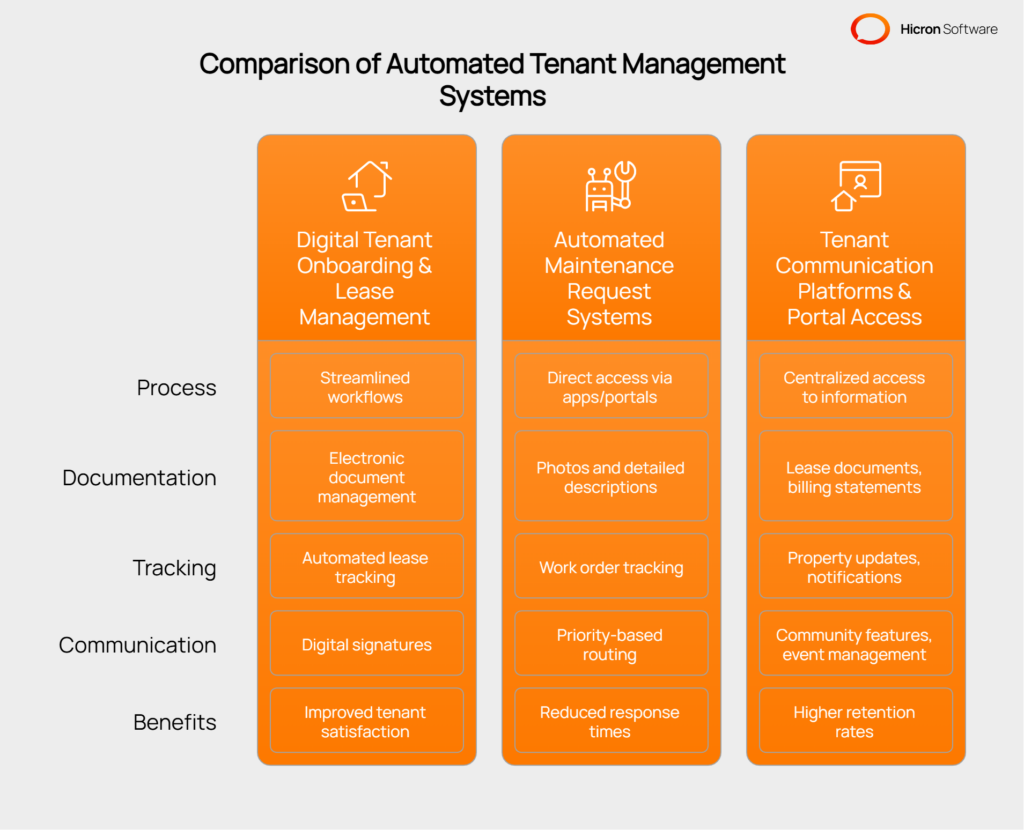
Financial transparency and accuracy form the foundation of positive landlord-tenant relationships. Traditional manual processes often lead to disputes and administrative burden. Automated systems eliminate these issues while providing valuable insights for both parties.
Traditional utility billing often relies on square footage allocation or fixed percentages that may not reflect actual consumption patterns. Modern metering systems track individual tenant usage for electricity, water, gas, and other utilities.
Smart meters provide real-time consumption data, enabling fair cost allocation based on actual usage rather than estimates. This transparency reduces disputes while encouraging conservation efforts that benefit the entire property.
Automated billing generation eliminates manual calculation errors while providing detailed breakdowns that help tenants understand their consumption patterns. Monthly reporting includes comparisons to previous periods and benchmarks against similar spaces, enabling tenants to identify opportunities for optimization.
Common Area Maintenance charges represent complex calculations involving multiple cost categories and allocation methods. Automated systems handle these calculations accurately, providing transparent reporting that fosters tenant trust.
Real-time expense tracking ensures CAM charges reflect actual costs rather than estimates, eliminating year-end reconciliation surprises that can strain tenant relationships. Detailed reporting shows exactly how shared costs are calculated and allocated among tenants.
Monthly CAM statements include supporting documentation and explanations that help tenants understand their obligations while identifying opportunities for cost reduction through shared efficiency initiatives.
Revenue-sharing lease arrangements require accurate sales reporting from tenants, traditionally handled through manual processes that create opportunities for disputes and errors.
Direct POS integration eliminates manual reporting while providing real-time visibility into tenant performance. Automated calculations ensure accurate profit sharing while creating detailed reporting that supports strategic planning for both parties.
Performance analytics help identify trends and opportunities for improvement, enabling collaborative efforts to increase sales and optimize space utilization. This data-driven approach strengthens relationships while maximizing revenue potential for all stakeholders.
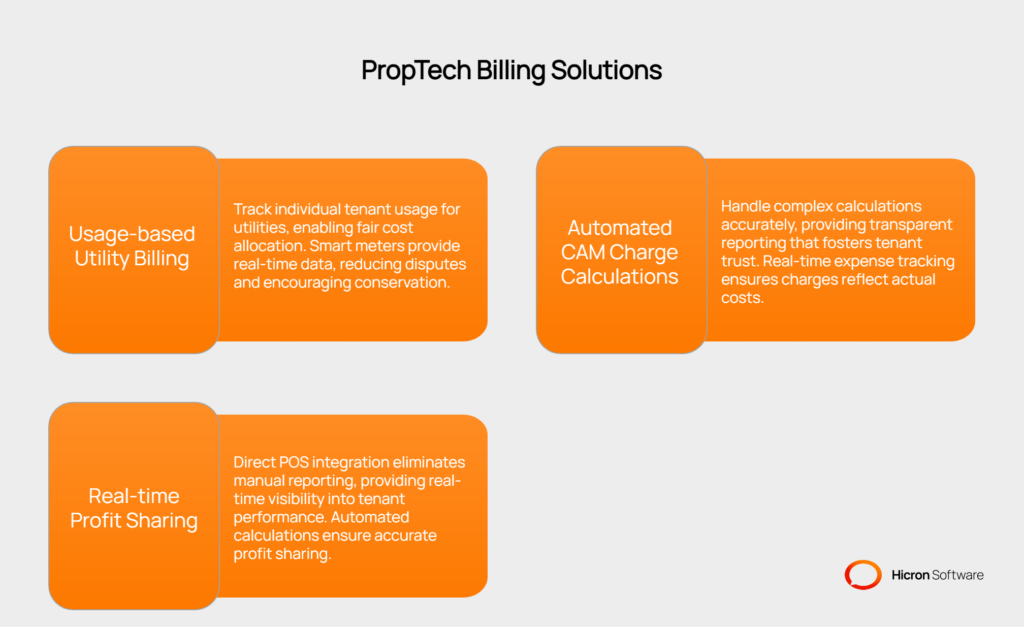
Energy and operational costs represent major expenses for commercial properties. Smart building technologies offer multiple pathways to reduce these costs while improving tenant satisfaction and environmental performance.
Internet of Things sensors create comprehensive monitoring networks that track everything from occupancy patterns to equipment performance. These systems provide real-time insights that enable proactive management and optimization decisions.
| IoT Sensor Type | Application Area | Key Benefit |
| Occupancy Sensors | Common areas, stores | Optimize staffing and reduce energy waste |
| Environmental Sensors | HVAC, lighting | Maintain comfort, improve air quality |
| Motion Sensors | Security, lighting controls | Enhance safety, enable energy savings |
| Leak Detectors | Restrooms, kitchens | Prevent costly water damage |
| Asset Tracking Sensors | Inventory, equipment | Reduce loss, improve asset utilization |
Occupancy sensors monitor space utilization throughout the day, identifying peak traffic periods and underutilized areas. This information guides decisions about staffing, security, and facility operations while providing valuable insights for tenant space planning.
Environmental sensors track temperature, humidity, air quality, and lighting levels to ensure optimal comfort while identifying opportunities for energy savings. Automated adjustments maintain ideal conditions while minimizing energy consumption.
Centralized dashboards provide property managers with comprehensive oversight capabilities from any location. Real-time data visualization enables the quick identification of issues and opportunities, supporting informed decision-making.
Customizable reporting tools generate insights tailored to specific management needs, from operational metrics to financial performance indicators. Automated alerts notify managers about critical issues requiring immediate attention.
Multi-property management capabilities enable portfolio oversight through a single interface, allowing for consistent management standards and efficient resource allocation across multiple locations.
Mobile applications extend property management capabilities directly to tenants and customers, creating enhanced experiences while reducing administrative workload.
Tenant apps provide access to lease information, maintenance requests, billing statements, and community features. Push notifications keep tenants informed about important updates while enabling direct communication with property management teams.
Customer apps offer wayfinding assistance, promotional information, event updates, and loyalty program integration. These tools enhance shopping experiences while providing valuable data about customer preferences and behavior patterns.
Operational costs consume portions of property budgets, making cost reduction a critical priority for successful property management. Retail PropTech solutions target multiple cost categories through systematic automation and optimization, enabling more efficient operations
.
Energy represents the controllable operating expense for most commercial properties. Comprehensive monitoring systems track consumption patterns and identify opportunities for optimization across all building systems.
HVAC optimization reduces energy consumption by 25-35% through intelligent scheduling and occupancy-based adjustments. Lighting controls provide additional savings of 40-60% while improving illumination quality for tenants and customers.
Demand response programs enable properties to participate in utility cost reduction initiatives while earning rebates for flexible energy usage during peak demand periods.
Traditional reactive maintenance approaches result in higher costs and more tenant disruptions compared to proactive strategies. Predictive maintenance systems monitor equipment performance and schedule service before failures occur.
Vibration analysis, thermal imaging, and performance monitoring can identify potential issues weeks or months before equipment failures occur. This early warning system enables scheduled maintenance during off-hours, minimizing tenant impact while extending equipment life.
A 30-50% reduction in maintenance costs is typical for properties implementing comprehensive predictive maintenance programs. Extended equipment life and reduced emergency repairs provide additional cost benefits over time.
Waste disposal costs continue rising while environmental regulations become more stringent. Smart waste management systems optimize collection schedules, improve recycling rates, and reduce disposal costs.
Fill-level sensors monitor dumpsters and recycling containers, enabling collection scheduling based on actual needs rather than fixed schedules. This optimization reduces collection costs by 20-30% while ensuring containers never overflow.
Recycling tracking systems help properties meet sustainability goals while identifying opportunities for waste reduction and material recovery that can generate additional revenue streams.
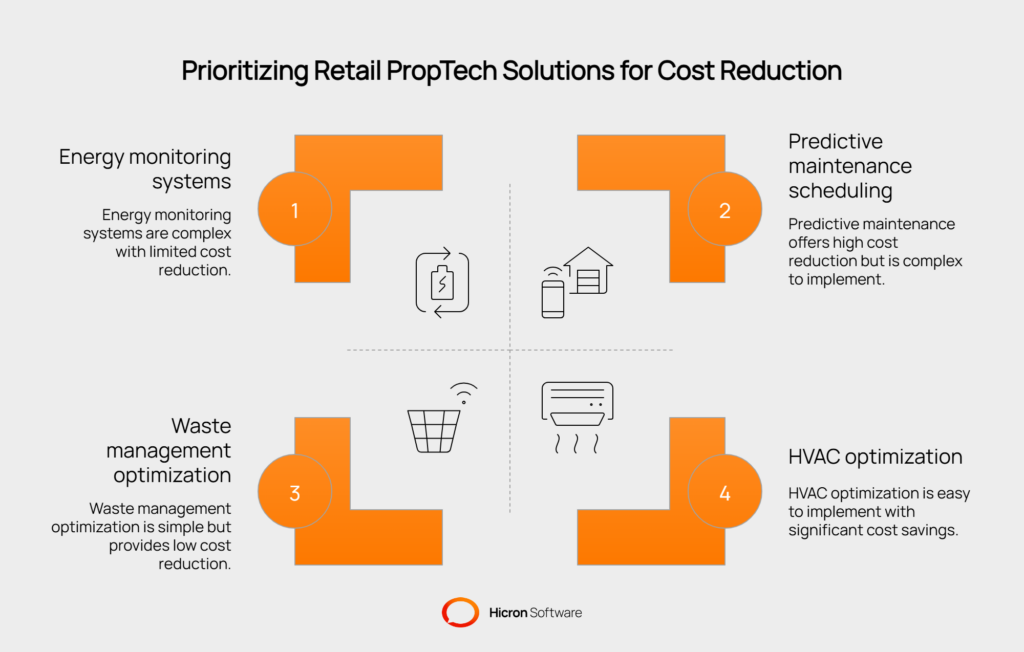
Comprehensive data collection enables strategic planning based on actual performance metrics rather than assumptions. Property managers can identify trends, optimize operations, and make informed investment decisions that drive long-term value creation.
Foot traffic patterns reveal valuable insights about space utilization and customer behavior. Heat mapping technology tracks movement throughout properties, identifying high-traffic areas and optimization opportunities.
Traffic flow analysis helps optimize store placement and common area design to maximize customer exposure for all tenants. Dead zones receive focused attention through layout modifications or programming changes that increase activity levels.
Seasonal pattern recognition enables proactive planning for peak periods while identifying opportunities to drive traffic during slower times through targeted marketing and promotional activities.
Real-time occupancy monitoring provides immediate insights into space utilization while supporting both operational decisions and long-term planning initiatives.
Peak capacity management prevents overcrowding during busy periods while identifying opportunities to attract more visitors during off-peak times. Safety compliance becomes easier with accurate occupancy tracking, ensuring adherence to fire codes and emergency evacuation procedures.
Space allocation decisions benefit from detailed utilization data that shows which areas generate the highest revenue per square foot and which spaces might be repurposed for more profitable uses.
Location-based pricing strategies maximize revenue from high-performing spaces while ensuring competitive rates for developing areas within properties.
Performance-based rent adjustments reward successful tenants while encouraging improvements in underperforming spaces. Market-responsive pricing keeps rental rates competitive while maximizing revenue from premium locations.
Lease renewal negotiations benefit from comprehensive performance data that demonstrates value creation for both landlords and tenants, supporting mutually beneficial agreements that encourage long-term relationships.
| KPI | Description | Operational Impact |
| Occupancy Rate | Percentage of leased space | Higher rates signal effective property management |
| Revenue per Square Foot | Total rental income divided by total area | Monitors property profitability and optimization efforts |
| Tenant Satisfaction Score | Survey-based feedback from tenants | High scores correlate with tenant retention |
| Energy Consumption per Area | Utility usage per square foot/meter | Tracks efficiency, cost savings, and sustainability goals |
| Lease Renewal Rate | Percentage of tenants renewing leases | Reflects property desirability and management performance |
| Average Downtime | Time between tenant departure and new lease | Short downtime boosts overall revenue and occupancy |
| Maintenance Response Time | Average time to address service requests | Faster response improves tenant satisfaction |
Modern PropTech platforms provide detailed analytics on foot traffic patterns, sales performance, energy consumption, and tenant satisfaction metrics. These insights enable property managers to identify opportunities for improvement and track progress against industry benchmarks.
Return on investment calculations for PropTech implementations require comprehensive tracking of both direct cost savings and indirect benefits such as improved tenant satisfaction and reduced vacancy rates.
Direct cost savings include reduced energy consumption, lower maintenance costs, and improved operational efficiency. Indirect benefits include higher rental rates, improved tenant retention, and enhanced property values resulting from technology-enabled improvements.
Payback periods for comprehensive PropTech implementations typically range from 18 to 36 months, depending on system complexity and property characteristics. Long-term benefits continue accumulating throughout the system lifecycle.
Effective measurement requires tracking metrics that align with business objectives while providing actionable insights for continuous improvement.
Occupancy rates, rental revenue per square foot, tenant satisfaction scores, and energy consumption per square foot provide baseline performance indicators. Customer traffic patterns, dwell time, and conversion rates offer insights into property appeal and tenant success factors.
Operational metrics, including maintenance response times, billing accuracy, and system uptime, demonstrate the effectiveness of PropTech implementations while identifying areas for optimization and improvement.
Industry benchmarking provides context for performance evaluation while identifying best practices that can be applied to improve property operations.
National and regional performance data help establish realistic targets while highlighting areas where properties excel or need improvement. Peer property comparisons provide insights into competitive positioning and market opportunities.
Performance trending analysis identifies improvement trajectories while forecasting future performance based on current initiatives and market conditions. This forward-looking approach supports strategic planning and investment decision-making.
Successful PropTech adoption requires careful planning and phased implementation to minimize disruption while maximizing benefits. Property managers should focus on high-impact areas that provide clear return on investment while building a foundation for expanded technology integration.
Start with systems that offer immediate benefits and clear ROI metrics. Energy management systems and automated billing typically provide quick wins that fund additional technology investments. Focus on tenant communication throughout the implementation process to ensure a smooth adoption and maximize the system’s benefits.
Staff training ensures property management teams understand new systems and can troubleshoot basic issues. Proper training maximizes system benefits, reduces vendor support costs, and builds internal expertise for ongoing optimization.
Regular system reviews identify optimization opportunities and ensure technologies continue meeting property needs. Establish key performance indicators that align with business objectives and track progress systematically.
Monitor tenant satisfaction, energy consumption, operational costs, and revenue metrics to quantify technology benefits. Use this data to justify additional investments and guide future technology decisions that support long-term growth objectives.
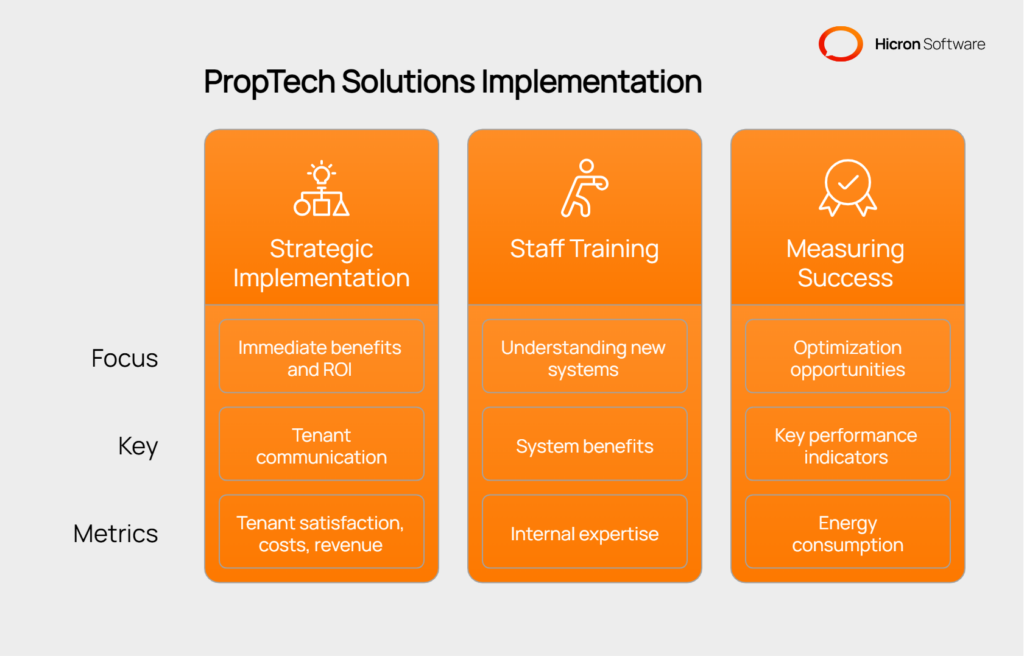
Technology adoption represents an ongoing journey rather than a destination. Successful properties build flexible technology infrastructures that can evolve with changing market conditions and advancing capabilities.
Cloud-based platforms provide scalability that accommodates property growth while enabling feature additions without significant infrastructure changes. API integration capabilities ensure new systems can connect with existing platforms, protecting technology investments while enabling expansion.
Modular system design allows properties to add capabilities incrementally, spreading costs over time while building comprehensive technology ecosystems that support all aspects of property management and tenant services.
Artificial intelligence and machine learning capabilities continue advancing, offering new opportunities for automation and optimization. Properties with flexible technology foundations can adopt these capabilities as they mature and prove their value.
Virtual and augmented reality applications hold promise for enhancing both property management and customer experience. Early adopters gain competitive advantages while building expertise in emerging technologies.
Blockchain applications may revolutionize lease management and financial transactions, while 5G networks will enable new categories of IoT applications and real-time services that enhance property operations and customer experiences.
Retail PropTech solutions provide comprehensive approaches to modern commercial property management challenges. By automating routine processes, delivering financial transparency, and optimizing operational costs, these technologies enable property managers to create more profitable, attractive, and resilient spaces.
The evidence clearly supports PropTech adoption across all property types. Properties implementing these solutions achieve improved occupancy rates, reduced operational costs, and enhanced tenant satisfaction while positioning themselves for long-term success in competitive markets.
For property managers ready to transform their operations, systematic PropTech adoption offers clear pathways to improved performance and sustainable growth. Start with high-impact implementations, maintain transparent communication with stakeholders, and build comprehensive technology strategies that support evolving market demands.
Implementation costs vary based on property size and system complexity. Basic automated billing systems start around $2-3 per unit monthly, while comprehensive smart building platforms range from $0.50 to 1.50 per square foot annually. Most systems achieve ROI within 12-24 months through operational savings, reduced energy costs, and improved tenant retention.
Modern PropTech platforms use enterprise-grade security, including encrypted data transmission, secure cloud storage, and regular security audits. Systems comply with relevant privacy regulations, such as GDPR and CCPA, allowing property managers to control data access and sharing permissions while maintaining tenant confidentiality.
Yes, most PropTech solutions are designed for retrofit installation. Wireless sensors, cloud-based software platforms, and smart meters can typically be installed with minimal disruption to existing operations. Some advanced systems may require electrical upgrades, but these are usually straightforward installations that can be completed during off-hours.
Advanced PropTech platforms accommodate various lease types, including percentage rent, common area maintenance charges, and custom cost allocations. Systems can be configured to handle unique arrangements while maintaining accuracy and transparency for all parties, reducing disputes and administrative overhead.
Reputable PropTech vendors offer comprehensive onboarding, including staff training, system configuration, and ongoing technical support. Many provide online training resources, regular system updates, and dedicated customer success teams to ensure optimal performance and user adoption throughout the technology lifecycle.
